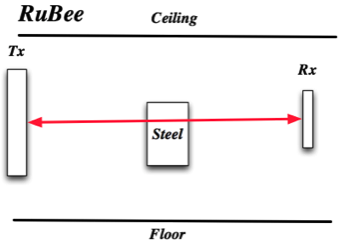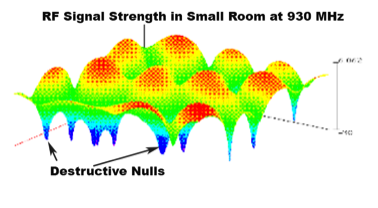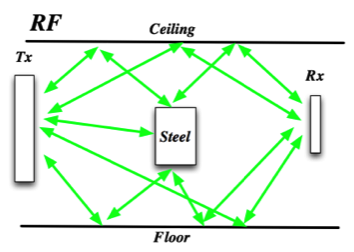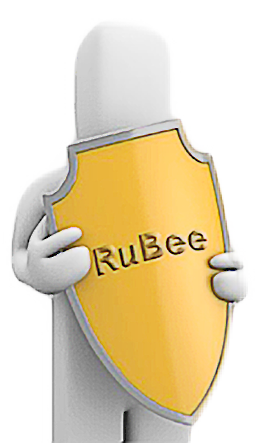
The RuBee Academy contains drill-down, in-depth technical background material describing the physics of RuBee, RuBee human safety, physical/cyber security and intrinsic safety.
Get a two page PDF summary fact sheet @ RuBee-Facts.
RuBee 101 Summary
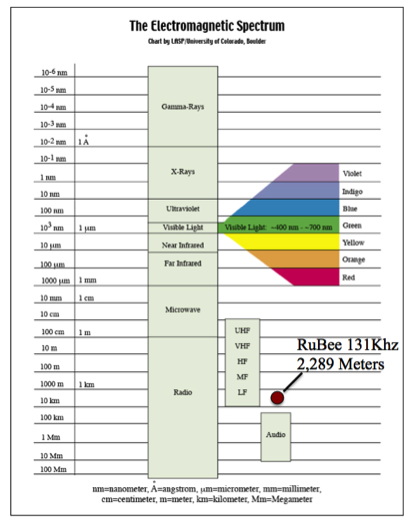
RuBee uses low frequency (131Kz) and has a wavelength of 2,289 meters, or about 1.25 miles. Unlike LF, HF, or UHF, RFID RuBee is an on-demand packet based protocol, similar to WiFi, Bluetooth and Zigbee. All active and passive RFID tags are transponders and reflect radio signals for data communication. RFID tags use the same signal for timing and power.
In contrast, RuBee works as a transceiver, similar to a two way walkie-talkie but uses magnetic waves rather than radio waves (see Maxwell's Equation below). RuBee tags have a crystal and can keep track of time, they also have a battery and static memory. RuBee tags can also have sensors and the ability to data log or store sensor information. Because RuBee uses such a low frequency, it does not consume much power (see Planck's Law below) and has a five to fifteen year battery life using simple Li coin size batteries with a range of 1" to 50 feet. RuBee tags overcome many of the technological problems seen with RF near steel and water, and is field proven in harsh environments. To learn more about the differences between RuBee and RF see RuBee vs RFID Summary.
Barcodes and RF systems are line-of-sight in harsh environments. RuBee is not line-of-sight in harsh environments; RuBee antennas produce 3D volumetric magnetic waves that go through steel and water. That means RuBee delivers reliable, real-time asset visibility with no Change In Process with Spatial Certainity.
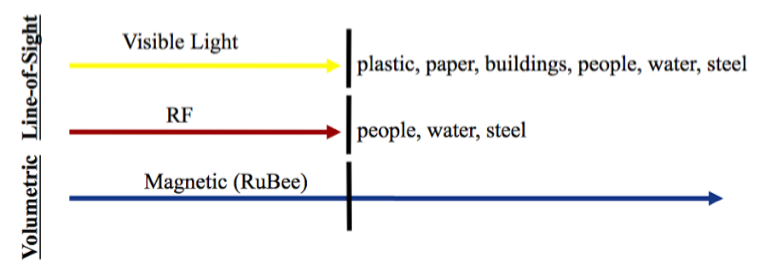
RuBee has the important advantage over other wireless technologies; it is not line-of-sight. Plastic, paper, buildings, water, people, and steel all block light. If you want to read a barcode, you have to take the barcode to the reader. The reader has to have a clear, unblocked view of the barcode. RFID is also blocked and reflected by water, people, and steel. Again, if you want to read an RFID tag in a harsh environment, you have to take the tag to a reader so it has a clear, unblocked view of the tag. RuBee tags are not blocked by anything read within a large 3D volume, and the signals are not blocked by water or steel (see Tag on I-Beam Underwater Video). RuBee works reliably in harsh environments because it uses magnetic waves, not radio waves.
RuBee 100% Read Accuracy and Reliability

Visible has over 20 (twenty) million hours of read time data, over five years in horrible, high noise harsh environments at over 1,200 remote worldwide sites to back-up this claim. All of our Defense and Industrial customers have a 100% read rate requirement. (see RuBee Armory 100% Accuracy, RFID Accuracy Issues).

RuBee has no nulls tied to multi-path refections. RuBee has what we call Spatial Certainty where the signal strength is a "tape measure" of distance to the tag. Once a RuBee tag is connected to a RuBee base station in a network it works 100% of the time. Lighting and other episodic noise events can block for one or two seconds, for one read, but on next attempted read, the tag is back to 100% read rate. RuBee has no destructive interference nulls in a harsh industrial environments.
However, at the same time RuBee magnetic fields are coherent. That means with phase controlled base stations we can actually intentionally sculpt a field in 3D. One side can be cancelled other side doubled or we can create a homogeneous field as seen below. We control that intentionally and actively with RuBee base stations, but not accidentally with multi-path reflections. The RuBee Portal Platform - RP2 has ability to control up to 20 phased synchronized base-stations down to a nano-second and can 3D sculpt a RuBee field.
How Does RuBee Achieve 100% Accuracy in Harsh Industrial Environments ?
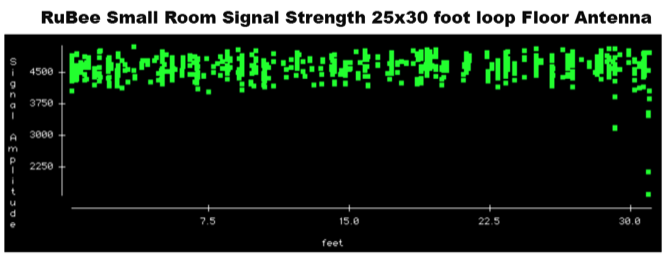

RF = High Delay Spread = High Room Nulls = Harsh Environment Challenges
RuBee = No Delay Spread = No Room Nulls = Harsh Environment Immune
RuBee and Human Safety

In July 2006, the FDA classified IEEE 1902.1 as a Non-Significant Risk (NSR) Class 1 device in medical visibility applications. In May 2007, a peer-reviewed study was published by the Mayo Clinic showing that RuBee has no effect on pacemakers or ICDs. A second Mayo study has shown RuBee has no significant EMI or EMC in the operating room (Mayo EMI Study) and FDA clearance. RuBee fields are about 1,000,000 (one million) times below the OSHA safety limits for RF exposure under IEEE C95.1 in un-controlled environments. Read more on the Human Safety Tab
RuBee Physical and Cyber Security: No Compromising Emminations.
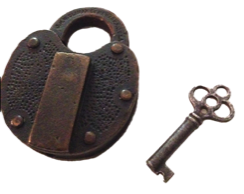
RuBee and Intrinsic Safety - HERO and HERF risk.
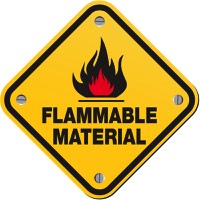
RuBee tags are safe on flammables and explosives (HERF ZERO) and are about one million times below the safety standard limit. RuBee tags antennas and base stations are Intrinsically Safe ANSI 913-88 standard in a Zone 1 or 2 explosive atmosphere as well as the DoD HERF standards. Read more on the Intrinsic Safety, RuBee HERO ZERO, and RuBee HERF ZERO tabs.
The Physics of RuBee Explains Intrinsic Safety, Human Safety, and Security Advantages
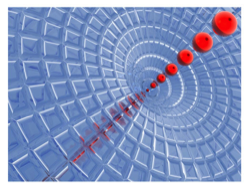
Maxwell’s equations quantified the relationship between E the electric field, and H, the magnetic field produced by an electron moving down a conductor. The two photons E and H are linked and impossible to disconnect. You can learn about Maxwell's equation and how E and H are tied together at this great Maxwell-Equations made simple website. A simplified explanation is also found at this URL: Elementary Particles. However, RuBee has no significant electric field for several reasons. First RuBee uses 131 KHz as base frequency and that has a wave length 7,509 feet (2,289 meters), about 1.5 miles. Rubee tags operate between 10 - 50 feet or about 1/700th of the wavelength; what we call the extreme near field. Second we can block the E in Maxwell's equation with material like carbon impregnated plastics or aluminum or even steel, and H still gets to the other side. We explain more below. RuBee antennas work like light bulbs, and illuminate a 3D volume with “magnetic field”.
A standard RuBee antenna produces about 600 mGauss and the tag produces about 50 mGauss. To put that in perspective, the Earth’s magnetic field is about 500 to 700 mGauss. Magnetic fields from earth or a permanent magnet do not have any effect on RuBee because they do not vary in time. When a magnetic field does vary in time (possible noise source), it usually has only short range effects on RuBee since signal strength drops off fast (see below). Typical RuBee noise sources are LCD projectors, plasma panel displays, switching power supplies, large transformers and lighting storms. However, RuBee demos and RuBee systems work in the same room with all of these noise sources, because the signal drop off so quickly.
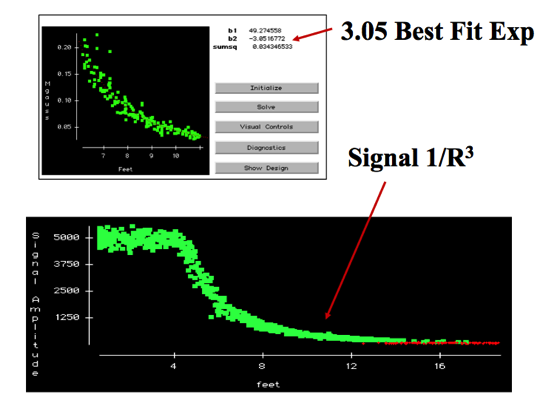
These graphs plot the RuBee signal in mGauss*100 vs distance from an antenna in feet. They show that the RuBee signal drops off 1/R to the 3rd power. In contrast, RF drops off 1/R. That means it is possible to eavesdrop on RF signals many miles away from its source. RuBee signals sink into deep space noise and can not be monitored at a distance. That provides a very high level of security over other wireless systems, and also minimizes any tempest or target risks. It also minimizes risk of noise interference. The most serious noise source for RuBee are bolts of lighting since they transmit electromagnetic signals hundreds of miles. However, even the most violent local lightening storm does not compromise RuBee data communication in any serious way, it just slows RuBee down by a few packets.
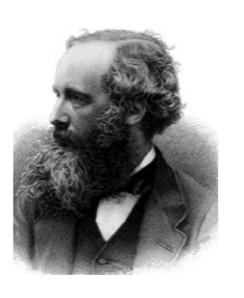
In 1856 James Clark Maxwell created his equations that described the relationship between the electric field (E) and magnetic field (H) produced by a moving electron. These equations are in effect "Ohms law" for moving electrons and describe the relationship between emitted radio waves (Voltage) and emitted magnetic waves (Current). The impedance or resistance of free space is 377 ohms. This is a universal constant and makes it possible to calculate the electric field (E) from the magnetic field (H) or vice versa. The electric field is given in Volts/meter and the magnetic field is given in Amps/meter and the ratio is E=H*377 in the "far field". This 377 ohm value (Z) is used by the FCC for example to calculate emitted power for all RF systems. The impedance of space Z in the is the ratio of the electric field to the magnetic field.
However, when emitted energy is measured at a distance of 1/10th of a wavelength or less it is in what is known as the "near field" and the 377 ohm constant goes out the window. RuBee has a wavelength of 7,509 feet, but tags are typically read in the 10 to 20 foot range or about 1/700th of a wavelength. The impedance of space seen by a RuBee tag is well under 0.00001 ohm not 377 ohms. That is the major reason why E becomes so small in near field (E = H * .00001); the simple explanation is E is shorted out. You would have to have a RuBee antenna about ¼ of a mile long and measure E and H about 1,000 feet away, before the impedance gets back up to 377 ohms. In other words, with a RuBee system (or any extream near field system) you cannot calculate E from H using 377 ohms; they are decoupled. Good news is magnetic waves, or magnetic photons are not stopped by steel or water.
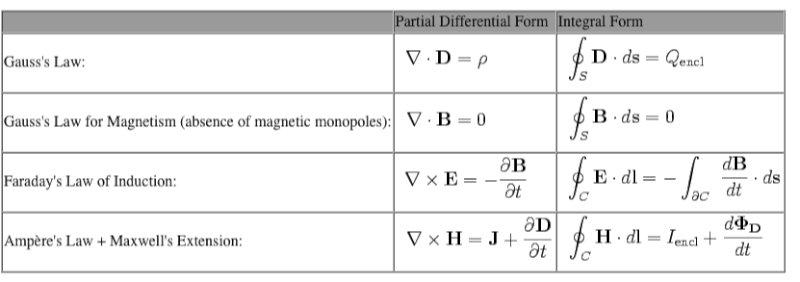
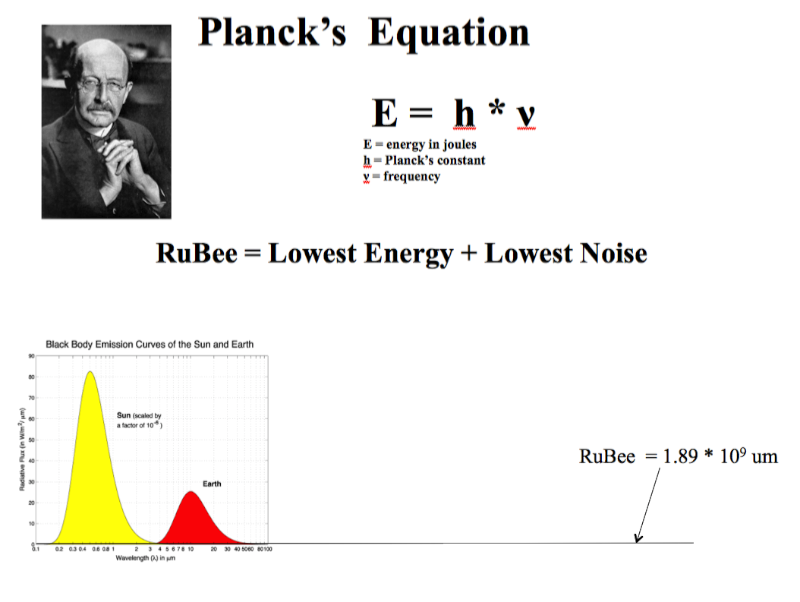
In 1901 Max Planck (Planck, Max. (1901). "On the Law of Distribution of Energy in the Normal Spectrum". Annalen der Physik, vol. 4, p. 553 ff.) discovered that energy contained in the photons emitted by a moving electron is directly proportional to its frequency. The proportionality constant is known as Planck's constant (E=h*v) . Max Planck received a Nobel price in 1918 for this fundamental discovery and it eventually led to many other fundamental discoveries linked to quantum mechanics. Because RuBee uses very low frequency (131 Khz) it does not require much energy. That also means it has no known EMI or EMC issues, is intrinsically safe, and has no known human safety issues. Moreover, RuBee signals are so small they do not even have any effect on magnetic strip credit cards. RuBee does not erase or affect magnetic cards at all.

